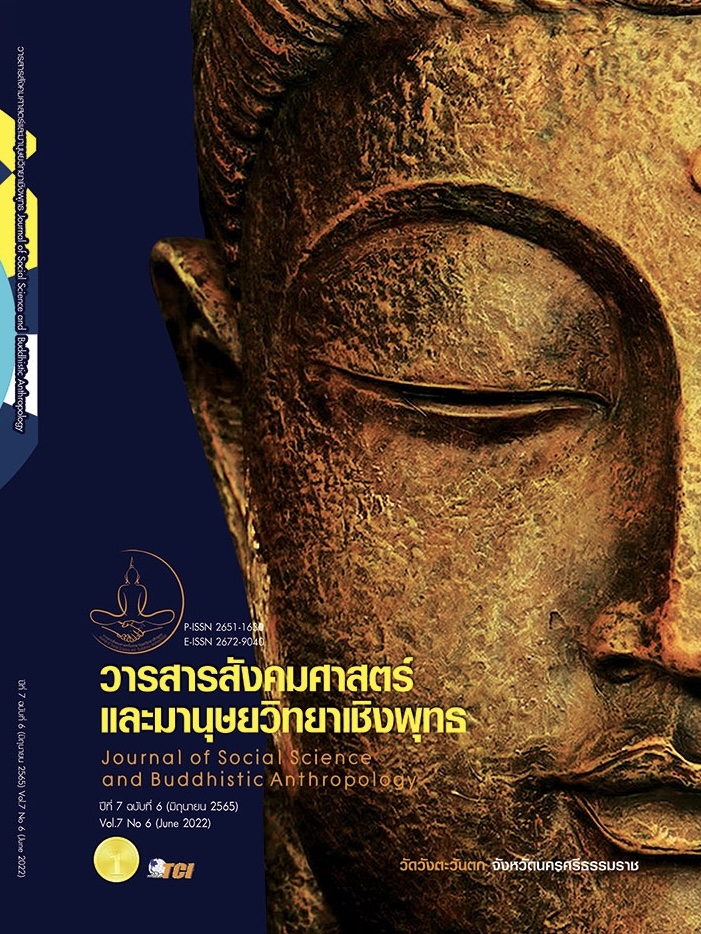ความร่วมมือระหว่างภาครัฐและเอกชน ในบริบทของความร่วมมือเพื่อผลิตและพัฒนาแรงงาน
คำสำคัญ:
ความร่วมมือระหว่างภาครัฐและเอกชน, การจัดการอาชีวศึกษา, การจัดการอาชีวศึกษา ระบบทวิภาคี, การประเมินผลการปฏิบัติงานขององค์การ, การประเมินผลการปฏิบัติงานขององค์การรูปแบบปริซึมบทคัดย่อ
บทความวิจัยฉบับนี้มีวัตถุประสงค์ 1) เพื่อศึกษาองค์ประกอบความร่วมมือระหว่างภาครัฐและเอกชน และ 2) วิเคราะห์ความสัมพันธ์องค์ประกอบความร่วมมือระหว่างภาครัฐและเอกชนในการผลิตแรงงานระหว่างสถานศึกษาอาชีวศึกษากับภาคอุตสาหกรรมที่สอดคล้องกับความต้องการ การวิจัยใช้ระเบียบวิธีวิจัยเชิงปริมาณ ศึกษาและวิเคราะห์องค์ประกอบความร่วมมือระหว่างภาครัฐและเอกชนในการผลิตแรงงานระหว่างสถานศึกษาอาชีวศึกษากับภาคอุตสาหกรรม จากการค้นคว้าเอกสาร ทฤษฎี และงานวิจัยที่เกี่ยวข้องในและต่างประเทศ กำหนดรายละเอียดองค์ประกอบแต่ละด้านตามรูปแบบการประเมินผลการปฏิบัติงานขององค์การรูปแบบปริซึม 5 ด้าน ใช้แบบสอบถามเป็นเครื่องมือในการเก็บข้อมูล คัดเลือกกลุ่มตัวอย่างแบบเฉพาะเจาะจง พื้นที่ในการศึกษาเป็นสถานศึกษาอาชีวศึกษาเอกชนซึ่งดำเนินการจัดการอาชีวศึกษาระบบทวิภาคี ภาคกลาง ภาคตะวันออก และกรุงเทพมหานคร จำนวน 58 แห่ง คุณสมบัติกลุ่มตัวอย่างเป็นผู้บริหาร ครู และบุคลากรของสถานศึกษาอาชีวศึกษาเอกชน เจ้าหน้าที่ และครูฝึกของสถานประกอบการที่เกี่ยวข้องกับการจัดการอาชีวศึกษาระบบทวิภาคีของสถานศึกษากลุ่มดังกล่าว สถานศึกษาละ 6 คน จำนวนทั้งสิ้น 348 คน วิเคราะห์ข้อมูลโดยใช้ ความถี่ ร้อยละ ค่าเฉลี่ย ส่วนเบี่ยงเบนมาตรฐาน การวิเคราะห์องค์ประกอบเชิงสำรวจ และการวิเคราะห์โมเดลสมการโครงสร้าง ผลการวิจัยพบว่า องค์ประกอบที่มีความสัมพันธ์ต่อ การดำเนินความร่วมมือระหว่างภาครัฐและเอกชนในการจัดการอาชีวศึกษาระบบทวิภาคี คือ องค์ประกอบด้านทัศนคติต่อการดำเนินความร่วมมือระหว่างภาครัฐและเอกชน และการแลกเปลี่ยนข้อมูลความรู้ โดยทั้งสององค์ประกอบมีค่าสัมประสิทธิ์สหสัมพันธ์ (r) ระหว่างกันที่ 0.837 แสดงว่าองค์ประกอบทั้งสองมีความสัมพันธ์กันอย่างมากในเชิงบวก ทั้งนี้ ภาครัฐมีบทบาททางอ้อมในการช่วยส่งเสริมสนับสนุนให้สถานศึกษาและสถานประกอบการดำเนินความร่วมมือระหว่างกันจนบรรลุเป้าหมายในการดำเนินความร่วมมือร่วมกันอย่างยั่งยืนในอนาคตต่อไป
เอกสารอ้างอิง
เบญจวรรณ ศรีคำนวล และคณะ. (2560). ปัจจัยที่ส่งผลต่อความสำเร็จในการจัดการอาชีวศึกษาระบบทวิภาคีของสถานศึกษาในจังหวัดลำปาง สังกัดสำนักงานคณะกรรมการการอาชีวศึกษา. Veridian E-Journal, Silpakorn University ฉบับภาษาไทย สาขามนุษยศาสตร์ สังคมศาสตร์ และศิลปะ, 10(2), 2535-2548.
ประภาพรรณ ปรีวรรณ และคณะ. (2559). รูปแบบความสัมพันธ์เชิงสาเหตุขององค์ประกอบที่ส่งผลต่อการพัฒนาการอาชีวศึกษาระบบทวิภาคี. วารสารบัณฑิตศึกษา มหาวิทยาลัยราชภัฏวไลยอลงกรณ์ในพระบรมราชูปถัมภ์, 10(2), 201-214.
พระราชบัญญัติการอาชีวศึกษา พ.ศ. 2551. (2551). ราชกิจจานุเบกษา เล่ม 125 ตอนที่ 43 ก หน้า 1-24 (5 มีนาคม 2551).
ศรเนตร อารีโสภณพิเชฐ. (2550). การพัฒนากลยุทธ์ความร่วมมือด้านการวิจัยทางสังคมศาสตร์ของสถาบันอุดมศึกษาของรัฐ. ใน ดุษฎีนิพนธ์ครุศาสตรดุษฎีบัณฑิต สาขาวิชาอุดมศึกษา. จุฬาลงกรณ์มหาวิทยาลัย.
ศูนย์อาชีวศึกษาทวิภาคี สำนักงานคณะกรรมการการอาชีวศึกษา. (2558). แนวทางปฏิบัติการจัดการอาชีวศึกษาระบบทวิภาคีตามประกาศกระทรวงศึกษาธิการ เรื่อง มาตรฐานการจัดการอาชีวศึกษาระบบทวิภาคี พ.ศ. 2557. กรุงเทพมหานคร: จามจุรีโปรดักส์.
สำนักงานเลขาธิการสภาการศึกษา. (2548). อาชีวศึกษาพัฒนาชาติ: บทเรียนจากสหพันธ์สาธารณรัฐเยอรมนี. (พิมพ์ครั้งที่ 2). กรุงเทพมหานคร: บริษัท พิมพ์ดีการพิมพ์ จํากัด.
สำนักงานสภาพัฒนาการเศรษฐกิจและสังคมแห่งชาติ. (2564). แผนการปฏิรูปประเทศ (ฉบับปรับปรุง). เรียกใช้เมื่อ 20 สิงหาคม 2564 จาก https://bit.ly/3ozX8LE
สำนักมาตรฐานการอาชีวศึกษาและวิชาชีพ สำนักงานคณะกรรมการการอาชีวศึกษา. (2562ก). หลักเกณฑ์และแนวปฏิบัติการจัดการอาชีวศึกษา ระดับประกาศนียบัตรวิชาชีพ และระดับประกาศนียบัตรวิชาชีพชั้นสูง เรื่องที่ 1 การจัดการอาชีวศึกษา. เรียกใช้เมื่อ 25 พฤษภาคม 2564 จาก https://bit.ly/3JOxcVC
สำนักมาตรฐานการอาชีวศึกษาและวิชาชีพ สำนักงานคณะกรรมการการอาชีวศึกษา. (2562ข). หลักเกณฑ์และแนวปฏิบัติการจัดการอาชีวศึกษา ระดับประกาศนียบัตรวิชาชีพ และระดับประกาศนียบัตรวิชาชีพชั้นสูง เรื่องที่ 8 การจัดการอาชีวศึกษาระบบทวิภาคี. เรียกใช้เมื่อ 25 พฤษภาคม 2564 จาก https://bit.ly/3Dn1rzY
สุมาลี จันทร์ชะลอ และเบญจมาภรณ์ จันทร. (2562). การจัดการศึกษาในระบบฝึกทวิภาคีในยุค 4.0. วารสารนวัตกรรมและเทคโนโลยีเพื่อการเรียนรู้ วิทยาลัยเทคโนโลยีสยาม, 2(1), 12-27.
Cronbach, L. J. (1984). Essentials of Psychological Testing. (4th ed.). New York: Harper & Row Publishers.
Freeman, R. E. et al. (2010). Stakeholder Theory: The State of the Art. The Academy of Management Annals, 4(1), 403-445.
Issayeva, G. K. et al. (2018). Public Private Partnerships in Education: Modes of Governance in Developing Economy. Retrieved August 20, 2021, from https://www.semanticscholar.org/paper/Public-Private-Partnerships-in-Education%3A-Modes-of-Issayeva-Abdikadirova/2135bd56abd181a32 efbaeba26dd3907de77ecea
Jane, I. O. (2018). Revamping Technical Vocational Education and Training through Public-Private Partnerships for Skill Development. Makerere Journal of Higher Education, 11(1), 73-91.
Kaiser, H. F. (1960). The application of electronic computers to factor analysis. Educational and Psychological Measurement, 20(1), 141-151.
Likert, R. (1961). New pattern of Management. New York: McGraw-Hill Book.
Linda, C. et al. (2021). Comparative VET European research since the 1980s: accommodating changes in VET systems and labour markets. Journal of Vocational Education & Training, 73(2), 295-315.
Liu, J. et al. (2015). Review of performance measurement: implications for public-private partnerships. Built Environment Project and Asset Management, 5(1), 35-51.
Neely, A. et al. (2001). The Performance Prism in Practice. Measuring Business Excellence, 5(2), 6-13.
Sweet-Holp, T. (2001). Public-private partnerships in education. (Electronic Thesis or Dissertation). Retrieved May 25, 2021, from https://etd.ohiolink.edu/
UNESCO. (2009). Regional contribution to Statistical Information Systems Development for Technical and Vocational Education and Training. Retrieved May 25, 2021, from http://unesdoc.unesco.org/images/0021/ 002160/216065e.pdf
ดาวน์โหลด
เผยแพร่แล้ว
รูปแบบการอ้างอิง
ฉบับ
ประเภทบทความ
สัญญาอนุญาต
ลิขสิทธิ์ (c) 2022 วารสารสังคมศาสตร์และมานุษยวิทยาเชิงพุทธ

อนุญาตภายใต้เงื่อนไข Creative Commons Attribution-NonCommercial-NoDerivatives 4.0 International License.








